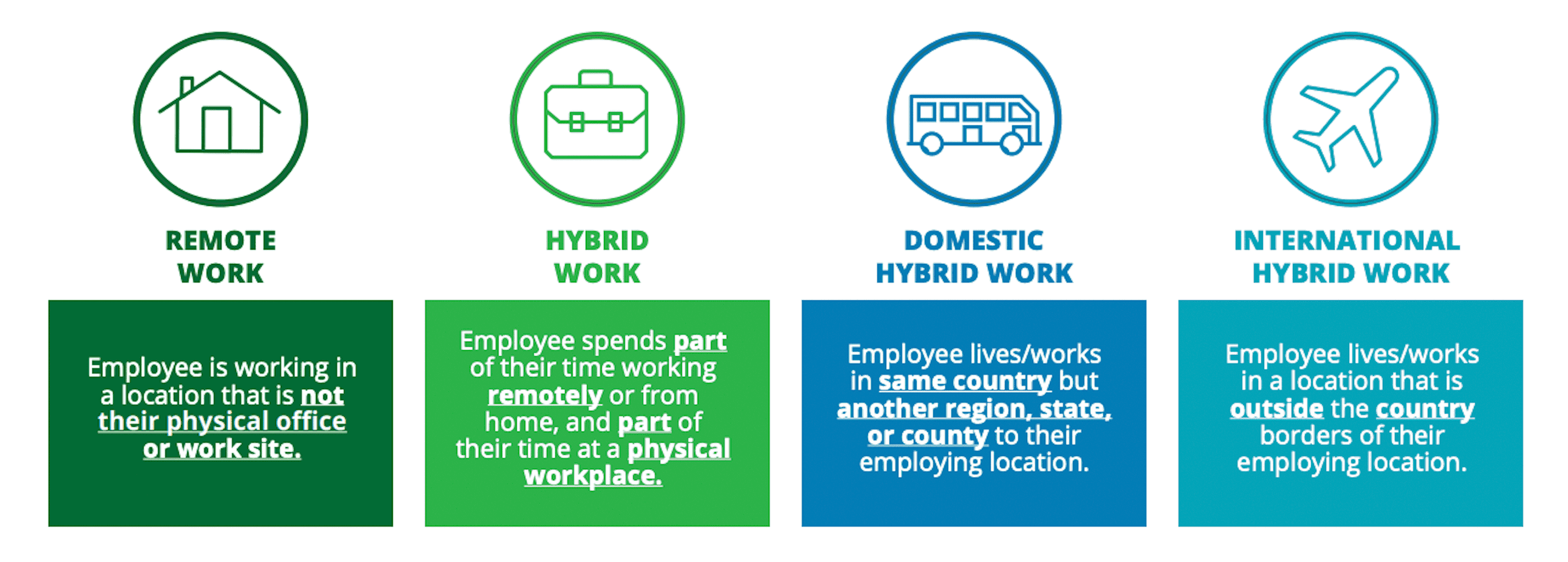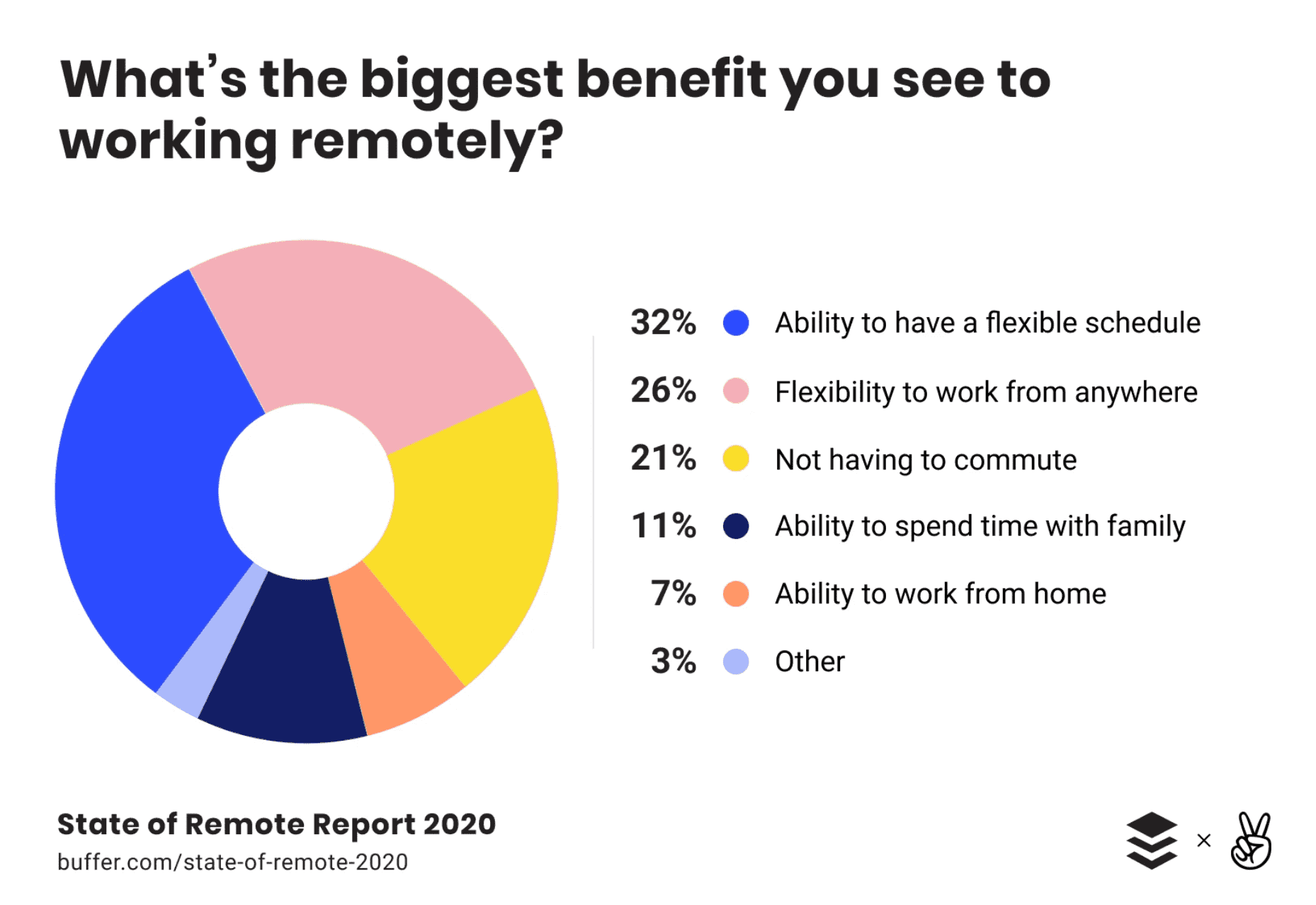Today, most development teams are scattered across different locations. We are exploring how to manage this type of software development team, sharing valuable insights and best practices that will enable you to maintain productivity and maximize your team's potential despite working from afar.
Remote Development Team: Trends and Stats
The ways we work in the future will likely look substantially different from what it does now. Remote work has quickly developed into a crucial business imperative high on the executive agenda and essential for maintaining and improving the quality of work.

Remote work models by Deloitte.
The State of Remote Engineering report identified that over 80% of developers seek to work remotely. The good news is that a lot of business executives and mobility leaders are upbeat about navigating the potential and constraints of remote work.
According to the Deloitte survey of over 820 tax, HR, mobility, and payroll industry professionals from 45 countries, more than 80% of firms have some sort of remote work policy in place. Remote work is now seen as a standard working practice.
The aim behind remote work rules and the measures adopted to manage or enforce them, however, appear to be at odds with one another. The main challenge that many organizations encounter is how to implement their policy on remote work in a way that strengthens their talent and culture strategies, while also managing the complex tax compliance and business risks that these remote workers may introduce and upholding their duty of care as employers.

Image Credit: Slack
Let’s try and figure out how to manage remote software developers efficiently.
Manage Remote Software Development Team Efficiently
Based on the research we’ve conducted and on our own experience with remote teams, we’ve lined up several most crucial steps you need to undertake.
Note: to make remote cooperation as effective as possible, you must first prepare your organization for the adaptation process and then find ways to manage remote developers.
Align Remote Work with Your Company’s Strategy
To align a remote work model to your organizational strategy, follow these steps:
- Assess the organization's goals and objectives: Understand the short-term and long-term vision of the organization to ensure that the remote work model will support and contribute to achieving these goals.
- Evaluate the remote work readiness: Assess the technology infrastructure, employee readiness, and managerial support for remote work. Identify any gaps that need to be addressed prior to implementing the remote work model.
- Develop a comprehensive remote work policy: Create a detailed policy that outlines expectations, communication protocols, performance management, and support structures for your future remote employees. Make sure it aligns with your organizational values and culture.
- Define roles and responsibilities: Clearly define which roles within your organization can effectively transition to remote work and establish guidelines for job responsibilities, accountability, and time management.
- Determine the appropriate technology tools: Identify and invest in essential technologies such as collaboration tools, project management software, and secure communication platforms that will support efficient remote work.
- Establish clear communication guidelines: Set expectations for how often employees should communicate with managers and team members through video calls, phone calls, or written updates. Encourage open dialogue to ensure clarity of expectations and maintain a sense of team cohesion.
Assess Related Risks
There are multiple reasons why it is important to assess the risks of adopting a remote or hybrid work model and various ways to conduct such an assessment.
Reasons to assess risks:
- Security concerns: Remote or hybrid work environments can pose security challenges, with confidential company data being accessed from various locations and devices, increasing the risk of data breaches or cyberattacks.
- Productivity: Remote work models can affect employee productivity, either positively or negatively, depending on individual preferences, work habits, and access to necessary tools.
- Employee engagement: The shift to remote or hybrid models may impact employee motivation, satisfaction, and overall engagement with the company.
- Communication and collaboration: A new work model may require adjustments in communication processes and collaboration tools to ensure effective team coordination.
- Compliance: It is crucial to assess whether remote working arrangements comply with local labor laws, health and safety regulations, and industry-specific regulations.
How to assess risks:
- Consultation and feedback: Engage employees in discussions about the potential benefits and challenges of implementing remote or hybrid working environments. This can help identify risks specific to your organization.
- Gap analysis: Evaluate the current infrastructure (technology, policies, etc.) against what would be required for supporting remote or hybrid work models in order to determine any areas that need improvement or updating.
- Pilot projects: Implement a pilot program where select employees work remotely for a certain period. This provides an opportunity to test the effectiveness of existing systems while identifying operational challenges.
- Information security assessment: Conduct an evaluation of potential cybersecurity risks and create an action plan to mitigate vulnerabilities by implementing secure practices, such as VPNs, data encryption, and multi-factor authentication.
- Benchmarking: Research the best practices in your industry related to remote or hybrid working arrangements by analyzing competitors' experiences or seeking expert advice from consultants.
Enable Remote or Hybrid Work Model
Companies can identify the routes to enable remote or hybrid work models by investing in the latest technology to manage and support remote or hybrid work models, as well as ensuring that the technology is user-friendly and accessible to everyone. This includes communication platforms, cloud-based software, and collaboration tools.
A defined set of policies, procedures, and project management guidelines should also be implemented to give every team member clarity on the company's expectations around remote work, especially when you opt for IT outsourcing. This involves defining the scope of each project, the minimum work hours required, and how employees can maintain communication and collaboration with the team.
Finally, the company culture should support the adoption of remote and hybrid work models. Providing adequate support to employees, like access to training and development opportunities, is paramount in encouraging and nurturing the adoption of new work models.
How can we help you achieve your digital goals?
Get in touchHire Self-Manged Professionals
Self-managed individuals are more likely to be disciplined, organized, and motivated, which is crucial for successfully completing tasks and meeting deadlines without constant supervision. Additionally, self-managed people are typically better at problem-solving and taking the initiative when challenges arise, ensuring seamless communication and efficient work processes. In a remote work environment, hiring self-managed individuals helps reduce management overhead and allows the company to focus on achieving its goals more effectively.
Furthermore, hiring self-managed individuals with several years of experience in a remote work environment can prove beneficial for companies. These individuals are already well-versed in techniques for staying focused and productive, managing their time effectively, and maintaining a healthy work-life balance, which is critical for remote work. Additionally, remote work requires employees to be comfortable using a variety of technological tools, such as video conferencing, chat platforms, and online project management tools. Self-managed employees are often tech-savvy and can effortlessly navigate and learn new technologies.
Create a Comfortable Communication Environment
While remote work offers many benefits, such as increased flexibility and reduced commuting time, it also comes with some challenges, like as a lack of face-to-face interaction, which can lead to miscommunication, decreased productivity, and even loneliness. The right tools can foster a comfortable communication environment, making it easier for team members to collaborate and stay connected despite working from different locations. For instance, video conferencing tools like Zoom and Google Meet provide a more visually engaging platform for communication and can help teams stay engaged and focused on the task at hand. Collaboration tools such as Slack and Microsoft Teams facilitate real-time messaging and file sharing, allowing teams to communicate and work together on projects seamlessly.
In addition to selecting the right tools, establishing a comfortable communication environment is crucial for remote work success. Companies can achieve this by creating clear communication guidelines and protocols, such as setting communication expectations for availability and response times. Doing so will help eliminate confusion and ensure that everyone is on the same page. Companies can also encourage the use of virtual team-building activities to help foster a sense of community and connection among team members.
*Note: Make sure you make each meeting meaningful. Don’t overload your remote staff with unnecessary calls when they can be perfectly communicated via email or Slack. *
Keep Time Zones in Mind
When you manage a remote development team, it's crucial to accommodate processes to each employee’s time zone. Here's why:
- By accommodating your workforce's time zones, you're giving them more flexibility, allowing them to work in their most productive hours. This, in turn, optimizes their work quality and efficiency.
- By understanding your team's time zones, you can schedule team meetings and establish deadlines that suit everyone's schedules. This reduces misunderstandings, delays, and miscommunications, leading to better productivity and a more positive work environment.
- By accommodating your team's time zones, you acknowledge their needs and demonstrate that you're invested in their success. This creates a more supportive work environment, which fosters trust and better teamwork.
- By being mindful of your team's time zones, you can ensure that they don't have to work odd hours, which helps to maintain a healthy work-life balance. This helps cultivate a healthy work-life balance.
Establish Regular Virtual Hang-Outs
Loneliness is cited as a major issue with remote employment in Buffer's State of Remote Report 2020. Regular online gatherings can be a terrific method to avoid this, especially for your team's more extroverted individuals.

By scheduling regular video conferences or even casual chats over messaging apps, you can significantly improve the quality of your remote team's communication and collaboration. When you are working with people that you have never met in person, it can be difficult to establish a sense of trust and reliability. When everyone on your team is on the same page and clearly understands each other's roles and responsibilities, you can avoid misunderstandings and delays due to poor communication.
Final Word
There’s no sole determination of how a modern workplace should look like. However, it is evident that more and more businesses see remote work models as essential to their culture, growth goals, and talent strategies. Businesses increasingly concentrate on turning their remote work journey from aspiration to action.
We hope this article helped you understand how to manage a remote software development team effectively.
Have any questions left? Contact us or visit our blog for more useful insights.







